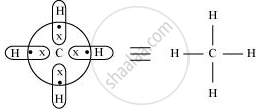Advertisements
Advertisements
प्रश्न
What do you understand by electron-precise? Provide justification with a suitable example.
उत्तर
Molecular hydrides are classified on the basis of the presence of the total number of electrons and bonds in their Lewis structures as:
Electron-precise hydrides:
An electron-precise hydride has a sufficient number of electrons to be represented by its conventional Lewis structure e.g. CH4. The Lewis structure can be written as:

Four regular bonds are formed where two electrons are shared by two atoms.
APPEARS IN
संबंधित प्रश्न
What do you understand by electron-rich compounds of hydrogen? Provide justification with a suitable example.
What characteristics do you expect from an electron-deficient hydride with respect to its structure and chemical reactions?
Do you expect the carbon hydrides of the type (CnH2n + 2) to act as ‘Lewis’ acid or base? Justify your answer.
Arrange the following:
LiH, NaH and CsH in order of increasing ionic character.
What do you understand by electron-deficient? Provide justification with a suitable example.
Name the classes of hydrides to which \[\ce{H2O, B2H6}\] and \[\ce{NaH}\] belong.
What do you understand by the term ‘auto protolysis of water’ ? What is its significance?
Molecular hydrides are classified as electron-deficient, electron precise and electron-rich compounds. Explain each type with two examples.
Hydrogen generally forms covalent compounds. Give reason.
An ionic hydride of an alkali metal has significant covalent character and is almost unreactive towards oxygen and chlorine. This is used in the synthesis of other useful hydrides. Write the formula of this hydride. Write its reaction with \[\ce{Al2Cl6}\].
